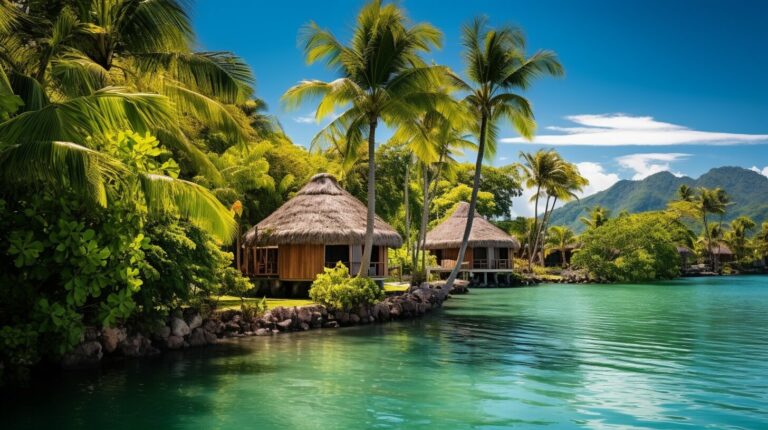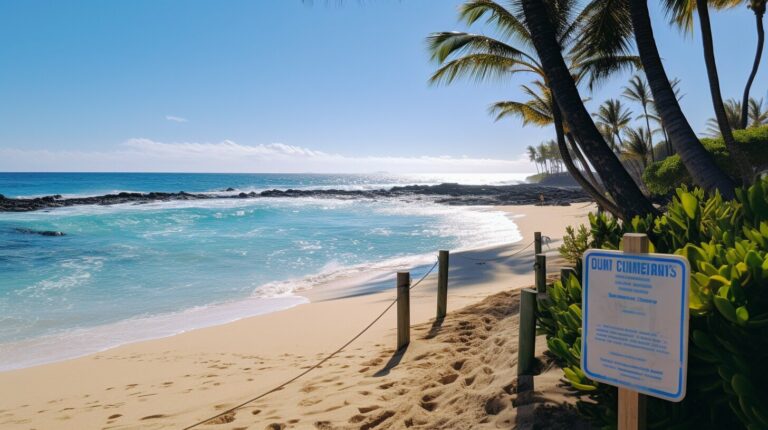Unveiling the Secrets of Hawaii’s Volcanic Heart 🌋
The Big Island of Hawaii is home to fascinating lava zones and active volcanic activity that has captured the attention of scientists and researchers. Recently, a significant discovery has been made by scientists on the island, shedding light on the behavior of Hawaii’s volatile volcanoes. Using 200,000 earthquakes and machine learning, a team of researchers has unveiled a collection of magma caches deep below the surface, which may act as the beating heart of these volcanoes. This discovery offers valuable insights into how magma travels from the deep mantle to the surface, providing us with a new window into the interface between the mantle and the crust.
The research conducted on the Big Island’s lava zones and volcanic activity has opened up new possibilities in understanding the mysterious ways in which lava flows from the deep to the surface. Experts in the field describe the study as elegant and intriguing, showcasing the ongoing efforts to unravel the secrets of the Hawaiian underworld. With this newfound understanding, scientists hope to continue studying the magmatic structures and uncover more about the fascinating volcanic activity that shapes the landscape of the Big Island.
Key Takeaways:
- The discovery of magma caches deep below the surface sheds light on the behavior of Hawaii’s volatile volcanoes.
- Machine learning and seismic data analysis have played a crucial role in uncovering these hidden structures.
- The research offers insights into the interface between the mantle and the crust, revealing how magma travels to the Hawaiian surface.
- Understanding the behavior of volcanoes is crucial for assessing volcanic risk and ensuring the safety of residents.
- The study highlights the ongoing quest to unravel the mysteries of the Hawaiian underworld and the fascinating volcanic activity on the Big Island.
Understanding the Kilauea Volcano Eruption
The Kilauea volcano eruption on the Big Island has left a lasting impact with its mesmerizing lava flow patterns and the profound changes it has brought to the landscape. This natural phenomenon has captivated scientists and tourists alike, offering a glimpse into the raw power and beauty of volcanic activity.
During the eruption, the lava from Kilauea flowed across the land, creating intricate patterns and formations. The molten rock, glowing with intense heat, carved its way through the surrounding terrain, shaping new landscapes and altering the existing ones. These lava flow patterns vary in size and intricacy, showcasing the unique behavior of the volcano. Some flows spread out in broad and majestic sheets, while others form narrow channels, resembling fiery rivers flowing down the slopes of the volcano.
The Kilauea eruption has also revealed the resilience of nature. Despite the destruction caused by the lava, new life emerges in its wake. Plants gradually colonize the barren fields of volcanic rock, transforming the once desolate landscape into a thriving ecosystem. This process of natural regeneration is a testament to the incredible resilience and adaptability of the flora and fauna on the Big Island.
| Lava Flow Patterns | Description |
|---|---|
| Sheet Flows | Wide, flat lava flows that resemble vast blankets covering the land. |
| Pahoehoe Flows | Smooth, ropy lava formations with a glossy surface, often resembling twisted ropes. |
| A’a Flows | Rough, jagged, and blocky lava flows, characterized by sharp fragments and rough textures. |
| Lava Tubes | Hollow channels formed by flowing lava, creating subterranean passages. |
The Intricate Dance of Destruction and Creation
The Kilauea volcano eruption showcases the ever-changing dynamics of our planet, where destruction and creation are intertwined. While the eruption brings devastation in its path, it also creates a fertile ground for future growth and renewal. The lava flow patterns, with their mesmerizing beauty, remind us of the delicate balance between chaos and order in the natural world.
As scientists continue to study the Kilauea eruption and its aftermath, they gain a deeper understanding of volcanic activity and its impact on the environment. These insights not only contribute to our knowledge of Earth’s geological processes but also assist in the development of strategies to mitigate the risks associated with volcanic eruptions.
Unraveling Nature’s Masterpiece
The Kilauea volcano eruption on the Big Island is an ongoing process, with the volcano exhibiting intermittent periods of activity. As scientists monitor and study these events, they unravel the complexities of this natural masterpiece. Each lava flow, every crack in the Earth’s crust, holds valuable clues that help us comprehend the mysteries of our planet’s underworld.
By understanding the lava flow patterns and the behavior of volcanoes like Kilauea, we gain a newfound appreciation for the delicate balance between destructive forces and the regenerative power of nature. The ongoing research and exploration on the Big Island continue to shed light on the fundamental processes that shape our world and inspire awe in the face of Mother Nature’s grandeur.
| Lava Flow Patterns | Description |
|---|---|
| Pillow Lava | Round or elongated blobs of lava that form underwater, resembling pillows. |
| Pele’s Tears | Small, glassy volcanic droplets formed when molten lava is thrown into the air and rapidly cools. |
| Spatter Cones | Small mounds of lava that form around a vent, created by explosive eruptions. |
| Crater Cones | Steep-sided volcanic cones formed by the accumulation of ejected materials around a crater. |
Mapping Lava Zones and Geological Hazards on the Big Island
Mapping lava zones and identifying geological hazards on the Big Island is crucial to ensuring the safety and preparedness of the local communities. With the recent discovery of magma caches deep below the surface, scientists have gained valuable insights into the behavior of Hawaii’s volcanoes. This breakthrough provides a new perspective on the relationship between the mantle and the crust, offering a glimpse into the mysteries of the Hawaiian underworld.
The study, which involved analyzing 200,000 earthquakes and utilizing machine learning techniques, has shed light on how magma from the deep mantle makes its way to the surface of the Big Island. By mapping lava zones, researchers can better understand the potential paths and patterns of volcanic activity. This knowledge is vital for developing effective evacuation plans and mitigating the risks associated with volcanic hazards.
In addition to mapping lava zones, it is equally important to identify and assess the geological hazards present on the Big Island. Volcanic eruptions can trigger a range of hazardous phenomena, including ashfall, pyroclastic flows, and lava flows. By understanding the specific hazards associated with each lava zone, authorities can tailor evacuation plans and public safety measures accordingly.
Geological Hazards on the Big Island
| Lava Zone | Geological Hazards |
|---|---|
| Zone 1 | Lava flows, volcanic gases |
| Zone 2 | Ashfall, pyroclastic flows |
| Zone 3 | Lava flows, volcanic gases, localized ground deformation |
| Zone 4 | Ashfall, volcanic gases, lahars |
| Zone 5 | Ashfall, pyroclastic flows, lahars |
By being aware of the geological hazards associated with each lava zone, residents and emergency responders can take appropriate measures to protect themselves and ensure the safety of the community. Regular monitoring and updates from the Hawaiian Volcano Observatory, coupled with robust evacuation plans, are vital in minimizing the potential impact of volcanic activity on the Big Island.
Assessing Volcanic Risk and Monitoring Systems
Volcanic risk assessment and effective monitoring systems play a vital role in predicting volcanic eruptions and safeguarding the lives and properties of those living near active volcanoes. The recent discovery of magma caches deep below the surface of the Big Island has underscored the importance of understanding volcanic activity in Hawaii. This breakthrough in scientific research has provided valuable insights into the behavior of these volatile and hazardous volcanoes, shedding light on how magma from the deep mantle travels to the Hawaiian surface.
The study, which involved analyzing 200,000 earthquakes and employing machine learning techniques, has opened a new window into the interface between the mantle and the crust. This knowledge is crucial for assessing volcanic risk and developing effective monitoring systems to detect signs of impending eruptions. By closely monitoring seismic activity, gas emissions, ground deformation, and other indicators, scientists can gain valuable information about the state of a volcano and make informed assessments of its potential hazards.
In addition to continuous monitoring, volcanic risk assessments take into account various factors such as historical eruption data, volcano morphology, geologic mapping, and the presence of vulnerable communities and infrastructure. By combining these data sources, scientists can create hazard maps and predictive models that aid in emergency planning and evacuation efforts. These tools are essential in mitigating the potential impacts of volcanic eruptions and ensuring the safety of residents in volcanic zones.
The ongoing research and advancements in volcanic risk assessment and monitoring systems aim to uncover more secrets of the Hawaiian underworld. By deepening our understanding of the processes that drive volcanic activity, scientists can better protect communities, preserve infrastructure, and minimize the disruptive effects of eruptions. As new technologies and data analysis techniques continue to emerge, we can expect further progress in our ability to predict, monitor, and respond to volcanic hazards.
| Methods of Volcanic Risk Assessment | Advantages |
|---|---|
| Seismic monitoring | – Early detection of volcano unrest – Provides real-time data on seismic activity |
| Gas monitoring | – Detects changes in gas emissions, indicating volcanic activity – Helps identify potential explosive eruptions |
| Ground deformation monitoring | – Measures changes in ground surface elevation, indicating magma movement – Assists in determining eruption potential |
Understanding Volcanic Landforms on the Big Island
The Big Island is a treasure trove of diverse volcanic landforms, showcasing the powerful forces of nature that have shaped its picturesque landscapes. From towering shield volcanoes to sprawling lava fields, this Hawaiian island offers a stunning display of volcanic activity. Let’s explore some of the remarkable volcanic landforms that can be found here.
One of the most iconic landforms on the Big Island is Mauna Loa, the world’s largest shield volcano. With its gentle slopes and massive size, Mauna Loa dominates the island’s landscape. This colossal volcano has experienced numerous eruptions over the centuries, resulting in vast lava flows that have expanded the island’s coastline and created new land.
The island is also home to the Kilauea volcano, one of the most active volcanoes in the world. Kilauea’s dynamic eruption history has given rise to unique features such as lava tubes and pit craters. These lava tubes, formed by underground rivers of molten rock, provide a glimpse into the intricate underground network of volcanic activity.
Notable Volcanic Landforms on the Big Island:
- Pu’u O’o: This volcanic cone is a result of continuous eruptions from Kilauea that started in 1983. It has been the main vent for lava flows, creating a dramatic and ever-changing landscape.
- Halema’uma’u Crater: Located within the summit caldera of Kilauea, this crater exhibits ongoing volcanic activity, with occasional lava lake formations that captivate visitors.
- Chain of Craters Road: This scenic road winds through an array of volcanic landscapes, showcasing the dramatic effects of lava flows on the island’s southeastern coast.
“The volcanic landforms on the Big Island are a testament to the power and beauty of nature. Each eruption and lava flow has left its mark, sculpting the land and creating a unique tapestry of landscapes.” – Dr. Sophia Lee, Volcanologist
Exploring the volcanic landforms on the Big Island is not only a visual delight but also a valuable opportunity to learn about the geological processes that have shaped our planet. The ongoing research and study of these landforms continue to deepen our understanding of volcanic activity and its impact on the Earth’s surface.
| Volcanic Landform | Description |
|---|---|
| Shield Volcano | A broad and gently sloping volcano characterized by thin lava flows that spread over a large area. |
| Lava Tube | A natural tunnel formed by flowing lava, which develops a solid crust while the molten rock continues to flow inside. |
| Crater | A bowl-shaped depression at the summit of a volcano, often formed by explosive eruptions or collapse of the volcano’s summit. |
Evacuation Plans in Volcanic Zones
With the inherent risks associated with living near active volcanoes, developing robust evacuation plans is essential to protect the lives and livelihoods of those residing in volcanic zones. The unpredictable nature of volcanic eruptions means that residents must be prepared to evacuate at a moment’s notice, and having a well-organized and practiced plan in place can make all the difference in ensuring their safety.
One crucial aspect of evacuation planning is establishing designated safe zones where residents can seek shelter during an eruption. These safe zones are strategically located outside of the immediate danger zone but within reasonable proximity to affected communities. They provide a secure space where individuals and families can find refuge until it is deemed safe to return home.
In addition to safe zones, evacuation plans also involve creating clear communication channels to disseminate crucial information to residents. This includes establishing emergency alert systems, such as sirens or text message notifications, that can quickly and effectively reach everyone in the affected areas. Regular drills and community education programs can further enhance awareness and preparedness, ensuring that residents know what to do and where to go when an evacuation order is issued.
It is important to note that evacuation plans extend beyond the initial response to an eruption. They also encompass strategies for long-term recovery and rehabilitation, as volcanic eruptions can cause significant damage to infrastructure and the environment. By considering the potential long-term impacts and incorporating them into evacuation plans, communities can better mitigate the effects of volcanic disasters and expedite the recovery process for those affected.
Evacuation Plan Checklist:
- Identify designated safe zones outside of the immediate danger zone
- Establish clear communication channels for emergency alerts
- Conduct regular evacuation drills and community education programs
- Develop strategies for long-term recovery and rehabilitation
In conclusion, robust evacuation plans are crucial for protecting the lives and livelihoods of those residing in volcanic zones. By establishing designated safe zones, implementing effective communication channels, and conducting regular drills, communities can better prepare for the unpredictable nature of volcanic eruptions. Evacuation plans should not only focus on the immediate response but also consider the long-term recovery and rehabilitation efforts. As scientists continue to uncover the mysteries of volcanic activity, it is essential for communities to prioritize their safety and well-being through comprehensive and well-executed evacuation plans.
| Evacuation Plan Checklist: | |
|---|---|
| Identify designated safe zones outside of the immediate danger zone | |
| Establish clear communication channels for emergency alerts | |
| Conduct regular evacuation drills and community education programs | |
| Develop strategies for long-term recovery and rehabilitation |
Uncovering the Mysteries of the Hawaiian Underworld – Conclusion
The exploration of lava zones and volcanic activity on the Big Island of Hawaii provides a window into the fascinating and complex geology that shapes this unique island, with ongoing research aiming to unlock more secrets of the Hawaiian underworld.
Recently, scientists on the Big Island made a significant discovery regarding the volcanic activity in Hawaii. By analyzing 200,000 earthquakes and utilizing machine learning, a team of researchers unveiled a collection of magma caches deep below the surface. These caches may act as the beating heart of Hawaii’s volcanoes, shedding light on how magma from the deep mantle travels to the Hawaiian surface. The newfound knowledge offers valuable insights into the behavior of these volatile and hazardous volcanoes.
This research not only provides a new understanding of the interface between the mantle and the crust, but it also holds the potential to solve the mystery of how lava flows from the deep to the surface. Experts in the field have described the study as elegant and intriguing, recognizing its significance in expanding our knowledge of volcanic processes.
With this breakthrough, scientists aim to continue studying the magmatic structures and uncover more secrets of the Hawaiian underworld. Their research paves the way for a deeper comprehension of the volcanic activity in Hawaii, which will contribute to better volcanic risk assessment and the development of more robust volcanic monitoring systems. Additionally, this knowledge will be instrumental in formulating comprehensive evacuation plans to ensure the safety and well-being of residents in volcanic zones.
As ongoing research progresses, we can look forward to further revelations about the volcanic landforms on the Big Island and a deeper understanding of the geological hazards that shape this volcanic paradise. The exploration of the Hawaiian underworld remains an enthralling journey of discovery, as scientists continue to unveil the secrets hidden within the lava zones and volcanic activity of the Big Island.
FAQ
Q: What did scientists discover about volcanic activity in Hawaii?
A: Scientists on the Big Island have discovered a collection of magma caches deep below the surface that may act as the beating heart of Hawaii’s volcanoes. This discovery sheds light on how magma from the deep mantle travels to the Hawaiian surface, providing valuable insights into the behavior of these volatile and hazardous volcanoes.
Q: How did scientists make this discovery?
A: Scientists used 200,000 earthquakes and machine learning to reveal the existence of these magma caches deep below the surface of the Big Island. This innovative approach allowed them to study the magmatic structures and uncover more secrets of the Hawaiian underworld.
Q: What does this discovery mean for understanding volcanic activity in Hawaii?
A: The discovery of these magma caches provides a new window into the interface between the mantle and the crust, helping scientists understand how lava flows from the deep to the surface. This insight is crucial for understanding the behavior of these volatile volcanoes and mitigating their potential hazards.
Q: How have experts described the research?
A: Experts in the field have described the research as elegant and intriguing. The use of 200,000 earthquakes and machine learning to uncover the magma caches deep below the surface is considered a significant advancement in understanding the volcanic activity in Hawaii.
Q: What further research is planned?
A: The researchers hope to continue studying the magmatic structures and uncover more secrets of the Hawaiian underworld. By further investigating these magma caches and their role in volcanic activity, scientists aim to gain a more comprehensive understanding of the processes at play in Hawaii’s volcanoes.
Source Links
- https://www.voanews.com/a/scientists-defy-force-of-nature-to-unlock-secrets-of-hawaii-volcano/4473638.html
- https://bigislandnow.com/2022/04/08/volcano-watch-how-tephra-deposits-unlock-the-secrets-of-kilauea-volcanos-explosive-past/
- https://www.washingtonpost.com/science/2022/12/22/hawaii-volcanoes-magma-chambers/







